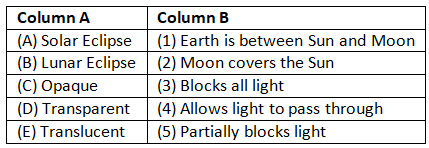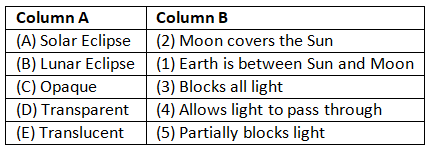Worksheet Solutions: The Sun, Earth and Moon— Light and Shadows | Eureka Plus Class 5: Book Solutions, Notes & Worksheets PDF Download
| Table of contents |

|
| Multiple Choice Questions (MCQs) |

|
| Fill in the Blanks |

|
| True or False |

|
| Match the Following (In a Table) |

|
Multiple Choice Questions (MCQs)
Q1: What is the primary source of light for Earth?
(a) The Moon
(b) Stars
(c) The Sun
(d) Fire
Ans: (c) The Sun
Q2: What do we call objects that do not allow light to pass through them?
(a) Transparent
(b) Translucent
(c) Opaque
(d) Reflective
Ans: (c) Opaque
Q3: During which phase does a solar eclipse occur?
(a) Full Moon
(b) New Moon
(c) Half Moon
(d) Waxing Crescent
Ans: (b) New Moon
Q4: What is created when an opaque object blocks light?
(a) Reflection
(b) Shadow
(c) Light
(d) Eclipse
Ans: (b) Shadow
Q5: Which of the following statements is true about the Moon?
(a) The Moon produces its own light.
(b) The Moon reflects sunlight.
(c) The Moon is a planet.
(d) The Moon orbits the Sun.
Ans: (b) The Moon reflects sunlight.
Fill in the Blanks
Q1: The __________ is the brightest object in the night sky.
Ans: Moon
Q2: An __________ object allows light to pass through it completely.
Ans: Transparent
Q3: A __________ eclipse occurs when the Earth is between the Sun and the Moon.
Ans: Lunar
Q4: When light is blocked by an object, a __________ is formed behind it.
Ans: Shadow
Q5: The Sun is located __________ kilometers away from the Earth.
Ans: millions
True or False
Q1: The Moon creates its own light. (True/False)
Ans: False
Q2: Light travels in a straight line. (True/False)
Ans: True
Q3: A total solar eclipse occurs when the Moon partially covers the Sun. (True/False)
Ans: False
Q4: Opaque objects can block light completely. (True/False)
Ans: True
Q5: Lunar eclipses last only a few minutes. (True/False)
Ans: False
Match the Following (In a Table)
 Ans:
Ans:














